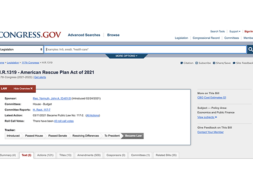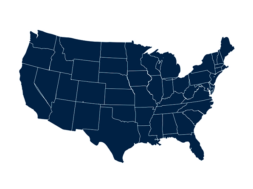
What Now? Examining the Regulatory Landscape After Gainful Employment Rule Scrapped
By Michael T. Wherry, Director, Audit Department, McClintock & Associates
The recent rescission of the Gainful Employment (GE) regulations is akin to watching a Stanley Cup hockey game going into overtime. With every shot, you are riding a wave of exultation or fear as the outcome of the game could occur at a moment’s notice.
Similarly, regulatory whiplash occurred over much of the last decades after the GE regulations were initially issued by the U.S. Department of Education (ED) on June 13, 2011, to be effective July 1, 2012. A court ruling on March 19, 2013, denied a request from ED to reinstitute certain GE provisions, including the required reporting, stemming from a June 30, 2012, lawsuit. The regulations were then reissued by ED on Oct. 31, 2014, and became effective on July 1, 2015.
As of July 1, 2019, the GE regulations have been rescinded effective as of July 1, 2020, or a postsecondary institution can elect to adopt the new rules immediately.
Take a breath. The game is over – for the moment, anyway. By now, institutions should know better than to assume the regulatory environment regarding financial reporting will stay the same for very long, but this recent decision ended a set of regulations that had a major impact on the for-profit sector, drawing a sigh of relief from leaders at those institutions.
With the regulatory landscape shifting, it’s a good time take stock at where things stand – and look forward to how they might change.
What is changing?
The GE rule was designed to determine if an educational program prepared students for “gainful employment in a recognized occupation” and measured how many graduates had an unsustainable amount of debt. Institutions determined this through a debt-to-earnings rate (D/E rates). Failing to meet the threshold impacted whether a program would be eligible for Title IV funding.
The initial impact of the ED’s decision is that the D/E rates are being eliminated and will not be used as a measure for an institution’s program to receive Title IV aid. Second, the rescission of the regulations results in less regulatory reporting. A school will no longer have to submit the annual GE Reporting information by Oct. 1 of each year, which was a voluminous amount of information on all students who received Title IV aid for the most recent award year. GE will still be audited for client year ending June 30, 2019, but the GE audit steps will mainly not be applicable as of Dec. 31, 2019, for year-end clients. The rescission results in the elimination of these items:
- Debt-to-earning rates
- Reporting of certain data elements in order to compute the D/E rates (GE reporting)
- Annual GE Disclosure Templates
- G/E student warnings
- Reviewing and correcting program completer lists
- Pending G/E appeals
- Senior official’s G/E certifications related to prerequisite state licensure or certification
- Programmatic Cohort Default Rates
What was the GE rule’s long-term impact?
In 2017, the first year of reporting, 98 percent of the 800 programs that failed to pass the standards were from for-profit institutions. Overall, 2,050 programs were identified as failing programs or programs in the warning zone, based on the 2015 GE rates, putting those programs at risk of losing eligibility for Title IV funding. While that’s a dramatic number, it’s worth noting that the vast majority of the for-profit and non-profit programs subject to the rule passed.
What regulators may not have fully appreciated when introducing the GE rule was that the institutions reporting the data had divergent student information systems and a varying level of internal personnel competency – it was not filed only by a handful of highly sophisticated schools. For some larger institutions, the volume of information reported made it impossible to review every data item for accuracy. For smaller ones, their systems may not have always pulled the proper information, and because of their size, they may not have always been able to employ personnel who understood all aspects of the regulations.
Postsecondary institutions also are experiencing a dramatic shift in their landscape similar to what the U.S. steel industry faced in the 1970s. From World War II until about a decade ago, post-secondary institutions had rising numbers of high school graduates, limited global competition and minimal technological disruptions. This has all changed in the last 10-15 years with the decrease in high school enrollments, global competition in education and online education.
In addition, during the time that the GE rule was effective, there was additional oversight from ED and state attorneys general. Certainly, some institutions weathered the regulatory storm better than others, and many – certainly, not all – are now fundamentally financially stronger. To survive, however, many institutions taught-out programs, lowered tuition or changed the educational structure of certain programs.
There were also some high-profile closures – notably, for-profit operators ITT Technical Institute, Corinthian Colleges and EDMC – which may have been influenced, in part, by the rule’s effects.
It will be difficult to gauge the overall impact the GE rule had on institutions, with various factors affecting those that closed or programs that were taught out. ED was also inconsistent in enforcing the regulation during the relatively short time the regulations were effective. A longer effective period would have given us a better sample size to determine its long-term effects, but certainly, it had immediate impacts – and concerns over its revocation already affected at least one financial reporting tool (more on that later).
Going forward, however, the rescission of the rule means less regulatory reporting and a $6.2 billion federal budget impact over the next decade, via Pell Grants and further student aid.
What reporting remains?
Institutions will continue to report a wealth of information to ED for various reasons. The majority of federal reporting will be done via the National Student Loan Database System (NSLDS), which includes enrollment history (dates, full time/part time), loan history (types of loans, amounts borrowed, amounts outstanding), institutional repayment rates and completion and transfer rates (graduation or withdrawal). NSLDS is ED’s central database and is used mainly for operational purposes. The information is utilized to ensure students receive the proper amount of Title IV aid, especially when a student transfers to a new institution, and for ED to determine when repayment on Federal loans should begin.
Institutions also have to report Federal Pell and Federal Direct Loan information through the Common Origination and Disbursement (COD) system. This is done as part of ED and the institution’s cash management procedures and disbursement reconciliation processes. Finally, institutions report information under the Integrated Postsecondary Education Data System (IPEDS), which is survey data collected by the National Center for Education Statistics, an agency loaned within ED. IPEDS is the primary source of data on postsecondary institutions.
What about the College Scorecard?
Just six weeks before the revocation of the GE rule, Education Secretary Betsy DeVos announced an expansion of the College Scorecard, the department’s online tool that allows consumers to compare colleges’ financial information, graduation rates and other important data. ED added 2,100 non-degree granting institutions to the Scorecard database, many of which were affected by the GE rule, and expanded the program-level data collected by the Scorecard.
According to the final regulation revoking the GE rule posted to the Federal Register, ED made the Scorecard changes “to address concerns that by rescinding the 2014 rule, some students would be more likely to make poor educational investments.” The Scorecard’s additions or potential changes:
- Program size (potential total awards conferred at the program level),
- Program level (total number of Title IV borrowers who completed the program),
- Median Federal student loan debt and monthly payment associated with that debt on a standard repayment period for borrowers who completed,
- Program-level data on median earnings of Title IV federal financial aid recipients for a specific number of years after completion (currently undefined),
- Student loan default and repayment rates,
- Could add median graduate PLUS loan debt and monthly payment associated with that debt on a standard repayment period, and
- Could add median parent PLUS loan debt and monthly payment associated with that debt on a standard repayment period.
While the information will be limited to Federal loans only (no institutional debt or Private Educational Loans included), this information will continue to be reported by a large disaggregated number of institutions using numerous student information systems. This submission of data on a program level will result in complexities at many institutions due to the volume of data, the capabilities of the systems utilized, or the competency of the personnel involved. As a side note, College Scorecard information is obtained from the NSLDS, IPEDS and administrative earnings data from tax records obtained from the Department of the Treasury (aggregated and de-identified estimates of institutional-level statistics).
What potential changes lie ahead?
It might be the understatement of the century to say Washington is divided. The rollback of the Obama-era GE rule unsurprisingly met a cool reception from Democratic lawmakers.
While the Republican DeVos derided the rule as being unfair to for-profit institutions, Democratic Rep. Bobby Scott, chairman of the House Education Committee, said in a statement that the repeal props up “low-quality” schools and urged Congress to pass a comprehensive reauthorization of the Higher Education Act.
Transparency and accountability are being discussed by both political parties. The rub is on them agreeing on these metrics and to what institutions they should apply. The Republicans want consistent outcome metrics leveled on all institutions, and the Democrats believe certain metrics should be solely related to for-profit institutions.
While bipartisan compromise on the regulatory environment in higher education is slim, if it does occur, it will likely center around items such as FASFA simplification and loan repayment plan simplification.
Agreement on institutional outcome metrics seems less likely, though both parties have discussed implementing an outcome metric related to repayment rates, in lieu of measuring the cohort default rate (CDR). The consensus appears to be that CDR may not be providing the desired outcomes and a Title IV repayment rate would be a better proxy of educational quality, or the value received for the cost incurred.
With a presidential election coming next year, a potential Democratic administration could reinstate the GE rule or implement something similar, being that a statutory change in the Higher Education Act’s gainful employment definition is unlikely. In the meantime, institutions would be wise to continue to monitor what the debt-to-earnings rate would be for each of their programs in order to assess the tuition being charged – with no concern of losing Title IV funding, of course.
Institutions also need to remember that the federal government isn’t the only game in town. They need to be closely watching their state legislatures. States such as New York and California have been attempting to pass legislation at the state level due to the rollback of Federal regulations.
The rescission of the GE regulations has eliminated, for the time being, a potential loss of Federal Title IV aid for individual programs and has reduced some reporting and disclosure items for an institution. However, in no means, is the rescission of the GE regulations an opportunity to coast in regard to monitoring regulatory changes. New regulations are being proposed in regard to accreditation and changes to the 90/10 regulation have been debated in numerous Congressional hearings.
No matter what the future holds, the one certainty is the regulatory landscape among for-profit and non-profit institutions will not remain the same. Vigilant monitoring and regular consultation with experts are a must, especially among smaller institutions that may not have the resources to fully address financial and regulatory reporting. Be sure: there’s always another season to be played in this regulatory hockey game.
MICHAEL T. WHERRY is a director within the audit department at McClintock & Associates, a Pittsburgh-based accounting firm that offers solutions to post-secondary educational institutions across the country. A Certified Public Accountant, Michael oversees the completion of annual audits (financial statement and student financial aid) and has over two decades of experience in the public sector. He is an expert in internal controls and processes, financial reporting under Generally Accepted Accounting Principles, the interpretation of standards and regulations and finding proactive solutions for complying with the Title IV regulations. Michael is also an active presenter at numerous national and regional post-secondary conferences and conventions, as he is requested to speak on various regulatory topics.
Contact Information: Michael Wherry, CPA // Director, Audit Department // McClintock & Associates // mwherry@mcclintockcpa.com // LinkedIn: https://www.linkedin.com/in/mike-wherry-a542259/











